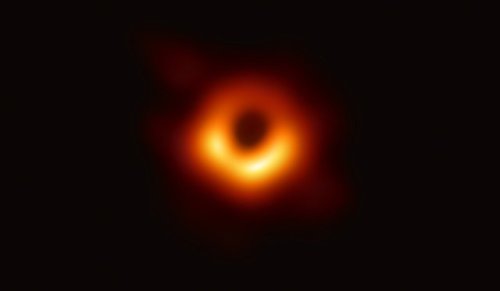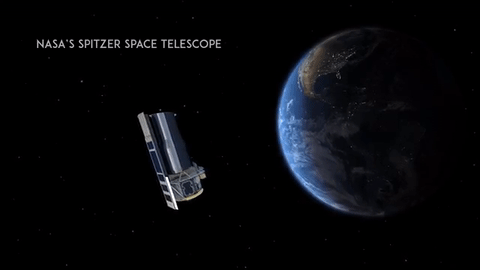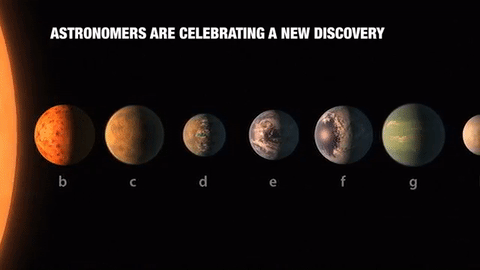Astronomers Capture First Image Of A Black Hole

Astronomers Capture First Image of a Black Hole
The Event Horizon Telescope (EHT) — a planet-scale array of eight ground-based radio telescopes forged through international collaboration — was designed to capture images of a black hole. Today, in coordinated press conferences across the globe, EHT researchers revealed that they have succeeded, unveiling the first direct visual evidence of a supermassive black hole and its shadow. The image reveals the black hole at the centre of Messier 87, a massive galaxy in the nearby Virgo galaxy cluster. This black hole resides 55 million light-years from Earth and has a mass 6.5 billion times that of the Sun. Supermassive black holes are relatively tiny astronomical objects — which has made them impossible to directly observe until now. As the size of a black hole’s event horizon is proportional to its mass, the more massive a black hole, the larger the shadow. Thanks to its enormous mass and relative proximity, M87’s black hole was predicted to be one of the largest viewable from Earth — making it a perfect target for the EHT. The shadow of a black hole is the closest we can come to an image of the black hole itself, a completely dark object from which light cannot escape. The black hole’s boundary — the event horizon from which the EHT takes its name — is around 2.5 times smaller than the shadow it casts and measures just under 40 billion km across.
Credit: ESO
More Posts from Delightfulskywalker and Others


gd x top

I'm a girl and I love science 😀
Science Side of Tumblr, I need your help! Ladies of the Science Side of Tumblr, I especially need your help!
I had a conversation at my non-science day job that went like this:
A friend who shall be called Diane (not her real name) comes to my desk to chat. Just one of the many topics we discuss is that her boyfriend is taking a class in wildlife biology. She has decided that she has grown tired of hearing about local wildlife and hearing him recite a plethora of scientific names.
I responded positively to this subject, and told her that I too found the subject interesting. A third person had heard our conversation. We shall call her Claire (again, not her real name). Claire immediately responded, “Girls don’t like that kind of thing.”
“Are you saying that girls don’t like science?” I asked.
“No, not normally they don’t,” she responded.
Before you all screech with anguish, bear with me for a moment. We all know that this is not true. As a man, I find this idea upsetting for countless reasons that have all been validly discussed before. To try to debate the issue is rather moot. Instead, I’d like a show of hands.
Ladies of the Science Side of Tumblr! I call you to arms! Will you rally around me in saying that women can and do indeed love science, of any variety? Gentleman of the Science Side of Tumblr who know someone who is a girl who also happens to love science, will you stand with me too? We all like and reblog the pro-women-in-science posts we see so often, let’s all stand and be counted in one place this time.
Reblog this if you are a woman who loves science. Reblog this if you are a man who knows a woman who loves science. Let us disprove her beyond all doubt!

Death Note; デスノート
Other fandoms: VIPs are such a mature fandom, supporting a romantic relationship and celebrating the first marriage for Bigbang members…
VIPS:

Solar Eclipse 2017

The Solar System

Largest Batch of Earth-size, Habitable Zone Planets
Our Spitzer Space Telescope has revealed the first known system of seven Earth-size planets around a single star. Three of these planets are firmly located in an area called the habitable zone, where liquid water is most likely to exist on a rocky planet.

This exoplanet system is called TRAPPIST-1, named for The Transiting Planets and Planetesimals Small Telescope (TRAPPIST) in Chile. In May 2016, researchers using TRAPPIST announced they had discovered three planets in the system.

Assisted by several ground-based telescopes, Spitzer confirmed the existence of two of these planets and discovered five additional ones, increasing the number of known planets in the system to seven.

This is the FIRST time three terrestrial planets have been found in the habitable zone of a star, and this is the FIRST time we have been able to measure both the masses and the radius for habitable zone Earth-sized planets.
All of these seven planets could have liquid water, key to life as we know it, under the right atmospheric conditions, but the chances are highest with the three in the habitable zone.

At about 40 light-years (235 trillion miles) from Earth, the system of planets is relatively close to us, in the constellation Aquarius. Because they are located outside of our solar system, these planets are scientifically known as exoplanets. To clarify, exoplanets are planets outside our solar system that orbit a sun-like star.

In this animation, you can see the planets orbiting the star, with the green area representing the famous habitable zone, defined as the range of distance to the star for which an Earth-like planet is the most likely to harbor abundant liquid water on its surface. Planets e, f and g fall in the habitable zone of the star.
Using Spitzer data, the team precisely measured the sizes of the seven planets and developed first estimates of the masses of six of them. The mass of the seventh and farthest exoplanet has not yet been estimated.

For comparison…if our sun was the size of a basketball, the TRAPPIST-1 star would be the size of a golf ball.
Based on their densities, all of the TRAPPIST-1 planets are likely to be rocky. Further observations will not only help determine whether they are rich in water, but also possibly reveal whether any could have liquid water on their surfaces.
The sun at the center of this system is classified as an ultra-cool dwarf and is so cool that liquid water could survive on planets orbiting very close to it, closer than is possible on planets in our solar system. All seven of the TRAPPIST-1 planetary orbits are closer to their host star than Mercury is to our sun.

The planets also are very close to each other. How close? Well, if a person was standing on one of the planet’s surface, they could gaze up and potentially see geological features or clouds of neighboring worlds, which would sometimes appear larger than the moon in Earth’s sky.

The planets may also be tidally-locked to their star, which means the same side of the planet is always facing the star, therefore each side is either perpetual day or night. This could mean they have weather patterns totally unlike those on Earth, such as strong wind blowing from the day side to the night side, and extreme temperature changes.

Because most TRAPPIST-1 planets are likely to be rocky, and they are very close to one another, scientists view the Galilean moons of Jupiter – lo, Europa, Callisto, Ganymede – as good comparisons in our solar system. All of these moons are also tidally locked to Jupiter. The TRAPPIST-1 star is only slightly wider than Jupiter, yet much warmer.
How Did the Spitzer Space Telescope Detect this System?
Spitzer, an infrared telescope that trails Earth as it orbits the sun, was well-suited for studying TRAPPIST-1 because the star glows brightest in infrared light, whose wavelengths are longer than the eye can see. Spitzer is uniquely positioned in its orbit to observe enough crossing (aka transits) of the planets in front of the host star to reveal the complex architecture of the system.

Every time a planet passes by, or transits, a star, it blocks out some light. Spitzer measured the dips in light and based on how big the dip, you can determine the size of the planet. The timing of the transits tells you how long it takes for the planet to orbit the star.

The TRAPPIST-1 system provides one of the best opportunities in the next decade to study the atmospheres around Earth-size planets. Spitzer, Hubble and Kepler will help astronomers plan for follow-up studies using our upcoming James Webb Space Telescope, launching in 2018. With much greater sensitivity, Webb will be able to detect the chemical fingerprints of water, methane, oxygen, ozone and other components of a planet’s atmosphere.
At 40 light-years away, humans won’t be visiting this system in person anytime soon…that said…this poster can help us imagine what it would be like:

Make sure to follow us on Tumblr for your regular dose of space: http://nasa.tumblr.com
Research
What would aliens think about research? By that, I mean the research of treacherous things, like volcanoes. Humans can send in drones to get samples or survey an environment, but sometimes, and especially in the times when research methods weren’t as advanced as today (or at times of space travel).
For example, Isaac Newton stuck a needle in his eye and poked around to study how humans perceive colors. (He did learn a lot but… eugh.) Sir Humphrey Davy generated chemical reactions and inhaled (potentially dangerous) gaseous products to note what happened. One scientist tried heart catheterization on himself when he couldn’t get approval to try it on a human.
Maybe aliens would think that humans were pretty dumb for doing all that, but it was early on, and these guys have learned better now.
Oh, no. There is currently a lava lake in Antarctica that occasionally spews a fall of fire now and then. Scientists go to that lake, in the freezing cold, with the risk of lava bombs spewing at them, to take measurements and make observations of the area. Sure, there are sensors too, but scientists still go to physically visit the area for data.
Scientists will go into submarines to study the deep ocean, a place with little or no sunlight and strange, possibly dangerous creatures. In addition, the pressure underneath all that water is immense. If a problem happened and the submarine was damaged, results could very easily be fatal.
Speaking of nature, there are scientists who will go into rainforests to meet 9possibly hostile) natives living within, or to learn more about animal behavior. It’s very risky work. There is a constant threat of predator attacks. The plants could kill you if you don’t pay enough attention. You could very easily catch a disease from the wildlife and fall gravely ill.
And what about space travel? Humans stuck themselves on rockets loaded with fuel and tried to get outside of the atmosphere. Sure, they ran tests and simulations, but no one knew for certain if it would really work. Some rockets exploded, killing the astronauts within. It was a very real possibility for anyone in a rocket but humans kept trying anyway.
Sure, humans take every safety precaution they can think of. Sure, they spend lots of time, energy, and resources to keep fellow humans as safe as possible. They still knowingly place themselves in possibly extremely dangerous situations for the sake of science. How strange is that?
-
 souponmyjorts liked this · 2 months ago
souponmyjorts liked this · 2 months ago -
 gahl-lak-tus reblogged this · 7 months ago
gahl-lak-tus reblogged this · 7 months ago -
 crimson-vipera reblogged this · 7 months ago
crimson-vipera reblogged this · 7 months ago -
 yearofthefishes liked this · 1 year ago
yearofthefishes liked this · 1 year ago -
 slasherslashpersonaltrainer liked this · 1 year ago
slasherslashpersonaltrainer liked this · 1 year ago -
 coinsgemznpnts liked this · 1 year ago
coinsgemznpnts liked this · 1 year ago -
 occhimacchiati reblogged this · 1 year ago
occhimacchiati reblogged this · 1 year ago -
 garedulest reblogged this · 1 year ago
garedulest reblogged this · 1 year ago -
 garedulest liked this · 1 year ago
garedulest liked this · 1 year ago -
 allthings-gold reblogged this · 1 year ago
allthings-gold reblogged this · 1 year ago -
 cirru-s reblogged this · 1 year ago
cirru-s reblogged this · 1 year ago -
 combjellys reblogged this · 1 year ago
combjellys reblogged this · 1 year ago -
 sufjans reblogged this · 1 year ago
sufjans reblogged this · 1 year ago -
 fronanunipprov liked this · 1 year ago
fronanunipprov liked this · 1 year ago -
 niteskai liked this · 1 year ago
niteskai liked this · 1 year ago -
 idrebnogim liked this · 1 year ago
idrebnogim liked this · 1 year ago -
 pigeonpantheon liked this · 1 year ago
pigeonpantheon liked this · 1 year ago -
 psy-rph liked this · 2 years ago
psy-rph liked this · 2 years ago -
 zhem1x5 liked this · 2 years ago
zhem1x5 liked this · 2 years ago -
 jsleamus reblogged this · 2 years ago
jsleamus reblogged this · 2 years ago -
 wonderwomanquinn liked this · 2 years ago
wonderwomanquinn liked this · 2 years ago -
 vintagedaisywitch liked this · 2 years ago
vintagedaisywitch liked this · 2 years ago
"Hope is like the sun. If you only believe it when you see it, you'll never make it through the night." -Princess Leia
286 posts